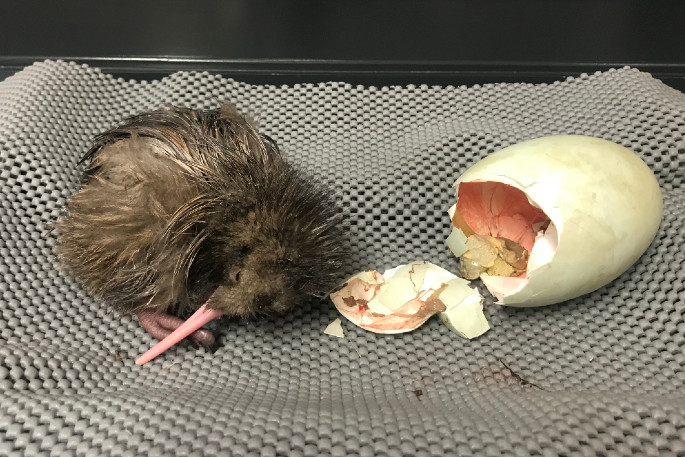The newest kiwi chick in the Bay of Plenty is already breaking records after hatching a day earlier than usual.
After four days of hatching, a kiwi chick emerged out of its eggshell at the National Kiwi Hatchery in Rotorua early on Sunday morning.
This is the earliest date a chick has hatched at the hatchery in the last ten years.
Assistant Hatchery manager Carole Dean was first on the scene.
'As we were in level four lockdown, we were working with reduced staff and Carole is working solo,” says Kiwi Hatchery manager Emma Bean.
'We candled the egg the night before and could see everything was tracking okay, so we determined we didn't need to come back after hours as we knew they would hatch just fine on their own.”
The chick had a hatch weight of 293.4 grams.
Hatch time is classified from the moment they poke their bill into the air pocket at the blunt end of the egg and breath air for the first time - also known as ‘internally pip' - to the first signs of cracking on the shell, known as ‘external pip', to actually hatching out of the shell.
Emma says it's not possible to tell if the newly hatched kiwi is female or male.
'Kiwi chicks have no ‘external features', to put it politely,” she says. 'We need to take a couple of feathers and send them away for DNA testing to find out.
'We can do this as soon as possible, Covid permitting, although we usually batch these samples. Results are usually returned within a week.”
The chick stayed in the hatch room for two days, before being moved into the brooder room, where they receive daily health checks.
'They will spend three-to-four weeks in there until he/she has moved onto food and re-attained hatch weight, before heading to our outside habitat area.” says Emma.
'They lose weight for the first week or so as they utilise the yolk they internalised prior to hatching, then once they're eating the weight goes back on again.”
Emma says kiwi are precocious, which means they hatch as fully feathered miniature adults with their eyes open.
'He/she was already trying to crouch when Carole arrived, and is already vocalising lots,” she says.
'In the wild they usually only stay with ‘dad' for a week, then head off on their own. They have a large yolk in their tummies which gives them nutrition while they practise how to feed, but probing and foraging is instinctive, so it doesn't take long for them to learn!”
Unfortunately this also makes them incredibly vulnerable to predation by introduced mammals, says Emma.
'Only five per cent kiwi chicks survive to six months old. That's why our work at the National Kiwi Hatchery is so important – we keep them safe when they are most vulnerable. Releasing them into the wild at a ‘stoat-proof' weight of 1kg increases their survival rates to over 65 per cent.”
The egg came from the Otanewainuku Kiwi Trust - one of the 15 different projects that the National Kiwi Hatchery works with across the North Island.

